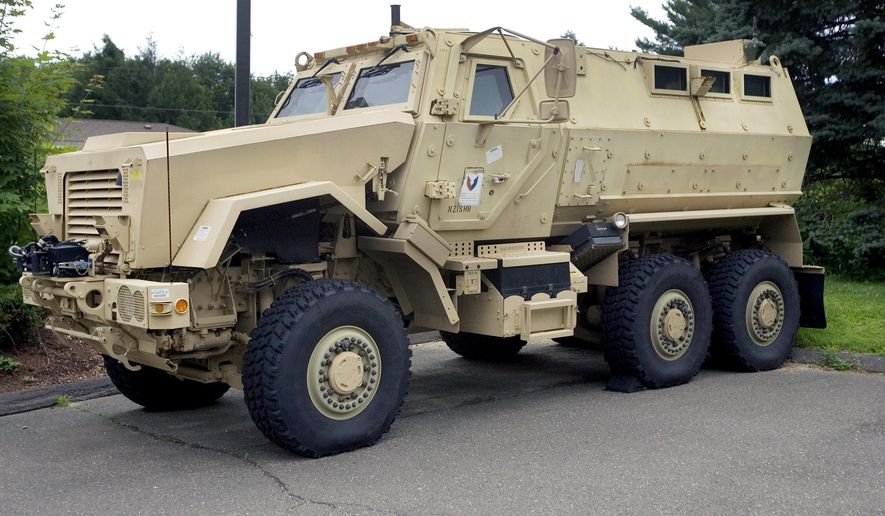OPINION:
Police departments around the country are under assault by the Democrats, who don’t want reform so much as dismantling and destruction.
And that makes it hard to find common ground for reform because nothing says anarchy like communities with dismantled and destroyed law enforcement departments, yes?
But peer past the madness of Antifa thuggery and all the bricks being thrown through storefront windows right now and the fact is police have needed reform for some time.
Even from a very pro-police, pro-law and order perspective, the fact is: Police have most definitely needed reform.
They’ve gone too militarized, rolling out the freebie armored vehicle cast-offs from the Army whenever there’s a drug suspect on the loose.
“Over several decades,” Wired reported, “the [Pentagon’s] 1033 program has shipped over $7.4 billion of Defense Department property to more than 8,000 law enforcement agencies.”
It matters because police are there to serve the citizens and maintain public safety; the military, at root, is to fight and win wars. There’s something that changes in an officer’s attitude when wearing blue shirt and trousers versus Kevlar, riot gear and body armor. There’s a mindset shift; there’s also a definite message to the public. It goes: Don’t mess with me.
And there are occasions in community policing when that mindset is appropriate, and occasions when it’s not. Over the years, those lines have maybe blurred. Do we seriously need Mine-Resistant Ambush Protected vehicles in places like Watertown, Connecticut?
But there’s more.
Police have moved too fast to take on scurrilous surveillance technology, to the point where citizens in public are treated as suspects, there for the license-plate reading, there for the red-light camera photographing.
There for the drone-snooping.
“How police are using technology like drones and facial recognition to monitor protests and track people across the U.S.,” Business Insider just wrote.
Here’s the current angle, from that same story: “The surveillance tech has reportedly been deployed across the U.S. as protests sweep the country following the death of George Floyd.”
It’s nothing new.
“Police employ Predator drone spy planes on home front,” the Los Angeles Times reported in 2011.
“Seattle mayor grounds police drone program,” Reuters reported in 2013, of a city police plan to fly “miniature robot drones equipped with stealth spy cameras” over the community, as part of law enforcement investigations.
Privacy?
Innocent until proven guilty?
Police have also been too complicit in collecting citizen data, saving citizen data and secretly sharing citizen data with their partners in government.
Not all databases are created equal — and not all crimes or criminals have to be fed into federal databases, or fusion centers, for super government storage.
Predictive technology, for one, has proven a bit of shaky constitutional business, sending police to respond to crimes before the criminal’s even had a chance to do the deed — a la science fiction, movie theater theatrics.
“Law enforcement agencies that use predictive policing consider it not only a technology, but also a process,” the American Police Officers Alliance wrote. “The tool consists of software that takes data and analyzes past criminal activity to anticipate where future crimes will take place.”
The data includes past hotspots of criminal activity, past suspects for criminal activity, past criminals and their criminal behaviors — and then feeds all that into an algorithm that then makes forecasts.
Here comes the “process” part: Police then act on these forecasts. They beef up patrols in certain areas, for example, or set up surveillance based on anticipated crime.
Or, in the words of a Constitution-loving civil libertarian: They overstep the bounds of the Fourth and Fifth amendments and the prohibitions against unreasonable searches and deprivations of life, liberty and property absent due process of law. Speaking of — civil asset forfeiture. Right? There’s another law enforcement program needful of reform, but quick.
The list goes on.
The list can certainly go on.
There are certainly several reforms police in America could make to help them from committing acts of overreach; to prevent them from trampling constitutional rights of innocent citizen; to hold them accountable when they do commit acts that violate their pledges and oaths to serve and protect; and to keep them in their proper roles — not as militarized aggressors but rather, servants to the people, like other government officials.
But the time for calm, cool discussion of these reforms has passed.
The Democrats have successfully radicalized any lessons that could be learned from George Floyd — any common grounds that could forged. And now the rhetoric is too heated for serious debate.
America is on the cusp of losing its law and order.
If only we had paid attention to the signs that pointed to the need for police reforms earlier. They were all there for the reading — right in the Constitution.
• Cheryl Chumley can be reached at cchumley@washingtontimes.com or on Twitter, @ckchumley. Listen to her podcast “Bold and Blunt” by clicking HERE. And never miss her column; subscribe to her newsletter by clicking HERE.




Please read our comment policy before commenting.